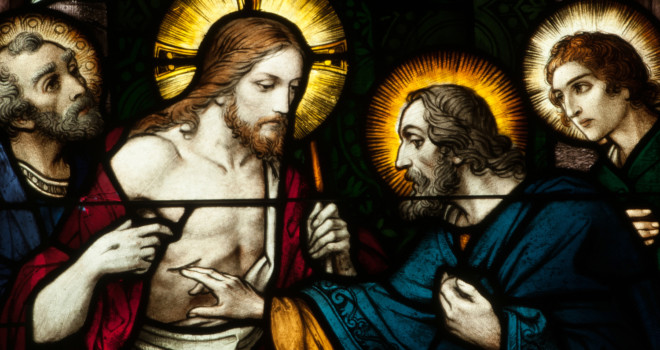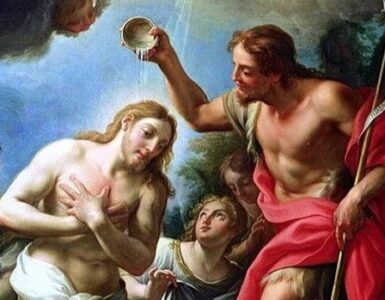Poor St. Thomas the Apostle. For much of the history of Christianity, he has been affiliated with one word: doubt. A “doubting Thomas,” says Wikipedia, “is a skeptic who refuses to believe without direct personal experience—a reference to the Apostle Thomas.”
Some Christians have even used the moniker to defend doubt as a kind of virtue. United Methodist minister Mark Schaefer and author of The Certainty of Uncertainty, argues that in “modeling doubt,” St. Thomas helps us understand “that faith and doubt are not antitheses—they’re twins.” Gerald M. Fagin, S.J., associate professor of theology at Loyola University, New Orleans, in turn argues in a 2007 article at America Magazine, “doubters like Thomas can be great teachers if they prompt us to examine our own faith.” Yet is “doubting” really even a fair label for the apostle?
Let’s consider the famous passage from which St. Thomas derives his notorious nickname.
In the first twenty-one verses of John 20, Mary Magdalene and then ten of the apostles witness the risen Christ. In John 20:20, we read that Jesus shows those apostles “his hands and his side,” namely, those places where his Roman executioners had pierced him with nails and a lance. When St. Thomas, who was not with them, returned, the disciples declared that they had “seen the Lord.” The missing apostle retorts: “Unless I see in his hands the print of the nails, and place my finger in the mark of the nails, and place my hand in his side, I will not believe.”
“Why doesn’t St. Thomas just believe like the rest of them?” we ask. It might seem at first glance that his refusal reflects some sort of deficiency on his part. Yet consider the scene again. All the other apostles were given the blessing of personally seeing the risen Christ. That St. Thomas did not get to experience this as well calls into question his apostolic status. Indeed, consider his words to his brethren. He wants the same experience as them — to see Jesus’ pierced hands and side. St. Thomas wants to witness what the other apostles witnessed precisely so he can maintain his status as one of Christ’s devoted, inner circle of followers.
Consider, too, how the risen Jesus treats St. Thomas when he appears again eight days later. Christ beckons the apostle: “Put your finger here, and see my hands; and put out your hand, and place it in my side; do not be faithless, but believing.” That Jesus willingly grants St. Thomas’ request does not sound like chastisement. Indeed, Jesus offers the request to a letter. St. Thomas places his hands in Christ’s side, a gesture of remarkable intimacy (imagine, by comparison, letting someone touch somewhere sensitive where you just had surgery!). Moreover, consider St. Thomas’ emphatic response: “My Lord and my God!” The so-called doubting apostle, in truth, is the only person in the Gospels who directly refers to Jesus as God!
“Wait,” you might retort. “Doesn’t Jesus in the very next verse (John 20:29) reprimand St. Thomas?” After St. Thomas’ exclamation, Jesus declares: “Have you believed because you have seen me? Blessed are those who have not seen and yet believe.” Yet is that necessarily to be interpreted as a reproof?
There is a similar exchange elsewhere in the Gospels where Jesus makes a comparison between a person and a group. In Luke 11:27-28, we read: “As he [Jesus] said this, a woman in the crowd raised her voice and said to him, ‘Blessed is the womb that bore you, and the breasts that you sucked!’ But he said, ‘Blessed rather are those who hear the word of God and keep it!’ Are Jesus’ words to be interpreted to mean that his mother Mary and her body are not to be considered blessed for being the vessel for the Incarnation? Surely not. Rather, Jesus employs a rhetorical device to direct his audience to an important truth: we must hear God and obey, as Mary did. Perhaps then Jesus is not scolding St. Thomas, but directing the apostles to a related truth: many will be called to believe in the resurrection without visible, physical proof.
Moreover, consider the few other anecdotes regarding St. Thomas elsewhere in the Gospels. In John 11:6, St. Thomas suggests to the disciples go to Judea with Jesus to die with him. Here the apostle stands in opposition to the others, who seek in John 11:8 to dissuade Jesus from traveling there because its inhabitants aimed to kill him. This doesn’t sound like a weak, vacillating follower of Christ, but someone passionately committed, as Dr. Jack Mulder noted in an April article at Catholic World Report. Similarly in John 14:5, following Jesus’ statements that he goes to prepare a place for the disciples, St. Thomas retorts: “Lord, we do not know where you are going; how can we know the way?” Certainly here the apostle is inquisitive, but precisely because he wants to follow Christ wherever he is going.
Scripture suggests St. Thomas, far from being the “doubter” of the apostolic cadre, may have been one of its most zealous members. Perhaps this, then, explains why St. Thomas became the Apostle of India, traveling perhaps farther than any other apostle to preach the Gospel, baptizing thousands of people on the Subcontinent, creating a Christian community that has lasted to this day. Says Catholic historian and Christendom College founder Warren Carroll: “To the land of the unreal, of negation, of double truth and untruth, of yearning for non-existence, of beatitude through death by starvation, he, Thomas, was to bring and to teach the utter reality, the shining glory.”
Nor should we forget the later Catholic saints who bear his name. St. Thomas Aquinas, following in his namesakes’ footsteps, passionately and unreservedly followed Christ, and his theological writings, including his unparalleled Summa Theologiae, represents a fuller manifestation of that same inherent human desire for evidence and proof found in the apostle.

Likewise St. Thomas Becket, that indefatigable archbishop of Canterbury, whose zealous love for Christ and Church inspired him to resist meddling English King Henry II, and for it pay with his life. And of course, that “man for all seasons,” St. Thomas More, esteemed official of the English government, brilliant humanist author, the “king’s good servant, but the Lord’s first,” martyred for refusing to countenance the sinful machinations of King Henry VIII.
Certainly the image of “Doubting Thomas” has offered glorious inspirations, like Caravaggio’s wonderful “The Incredulity of Saint Thomas” (c. 1602). Yet St. Thomas was no doubter… at least, no more than the other apostles. To label him such is to fall into what Carl E. Olson calls “tidy stereotypes about biblical figures, robbing them of some of their humanity and complexity.” Let us dispense with this unfair moniker, and call him, more justly, “Believing Thomas,” “Devoted Thomas,” or “Zealous Thomas.” Such names better befit the Apostle to India.
✠
image: Stained glass window depicting the Apostle Thomas putting his hand in the side of Jesus in the Church of the Immaculate Conception, Connellsville / photo by Nancy Bauer / Shutterstock.com












